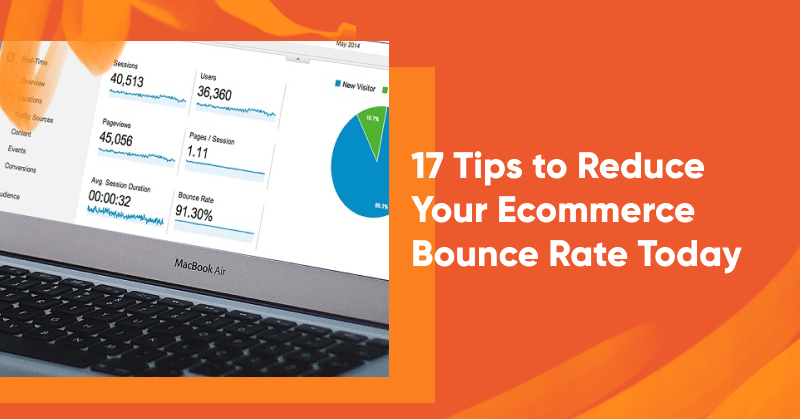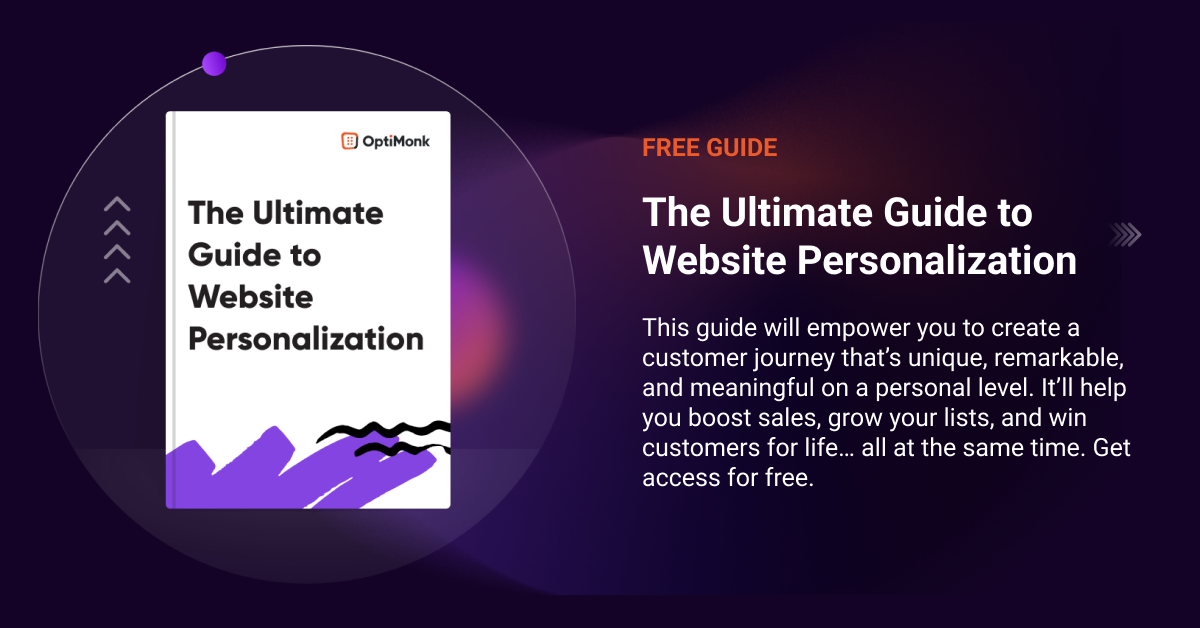If you’ve spent even a little bit of time on an analytics blog or website, you’ve probably come across an article on bounce rate.
Just about everyone has an opinion, and it’s a polarizing metric in terms of its value in the overall conversion funnel. If you’re still looking to get a better understanding of bounce rate and its importance in ecommerce, pull up a seat and get comfortable!
This article will help you understand what bounce rate is, why you should aim for a lower bounce rate, and which proven strategies can help you get there (and achieve higher conversions).
Ready? Let’s jump in!
What is a bounce rate?
Bounce rate refers to the percentage of visitors to your website who never make it past the landing page. Think of them as the online counterpart to customers who walk into a brick-and-mortar store and turn right back around before even checking out the first table of merchandise.
Not good!
It’s arguably one of the most important “raw” metrics, showing you how well your ecommerce site is converting people.
How to calculate your bounce rate?
To calculate your bounce rate, you divide the total number of one-page visits by the total number of website visits. The percentage you derive from that calculation is your bounce rate.
Bounce Rate = Total One-Page Visits / Total Website Visits
Typically, the lower your website’s bounce rate, the better your website is doing in terms of keeping visitors interested and potentially converting them.
So what’s considered a good bounce rate?
The general rule of thumb is that a good bounce rate is as low as possible.
As with many metrics, bounce rates vary greatly across industries. What’s considered a good bounce rate in one industry may be a horrible one in another.
Remember, bounce rates don’t tell the full story of how well a business is performing. However, they’re a good indicator of a business’ efficiency in converting website visitors.
HubSpot created a handy infographic that breaks down general bounce rate stats across industries. The findings in this infographic show that bounce rates tend to be around:
- 40-60% for content websites,
- 30-50% for lead generation sites,
- 70-98% for blogs, and
- around 33.9% average (20-40%) for retail and ecommerce sites.
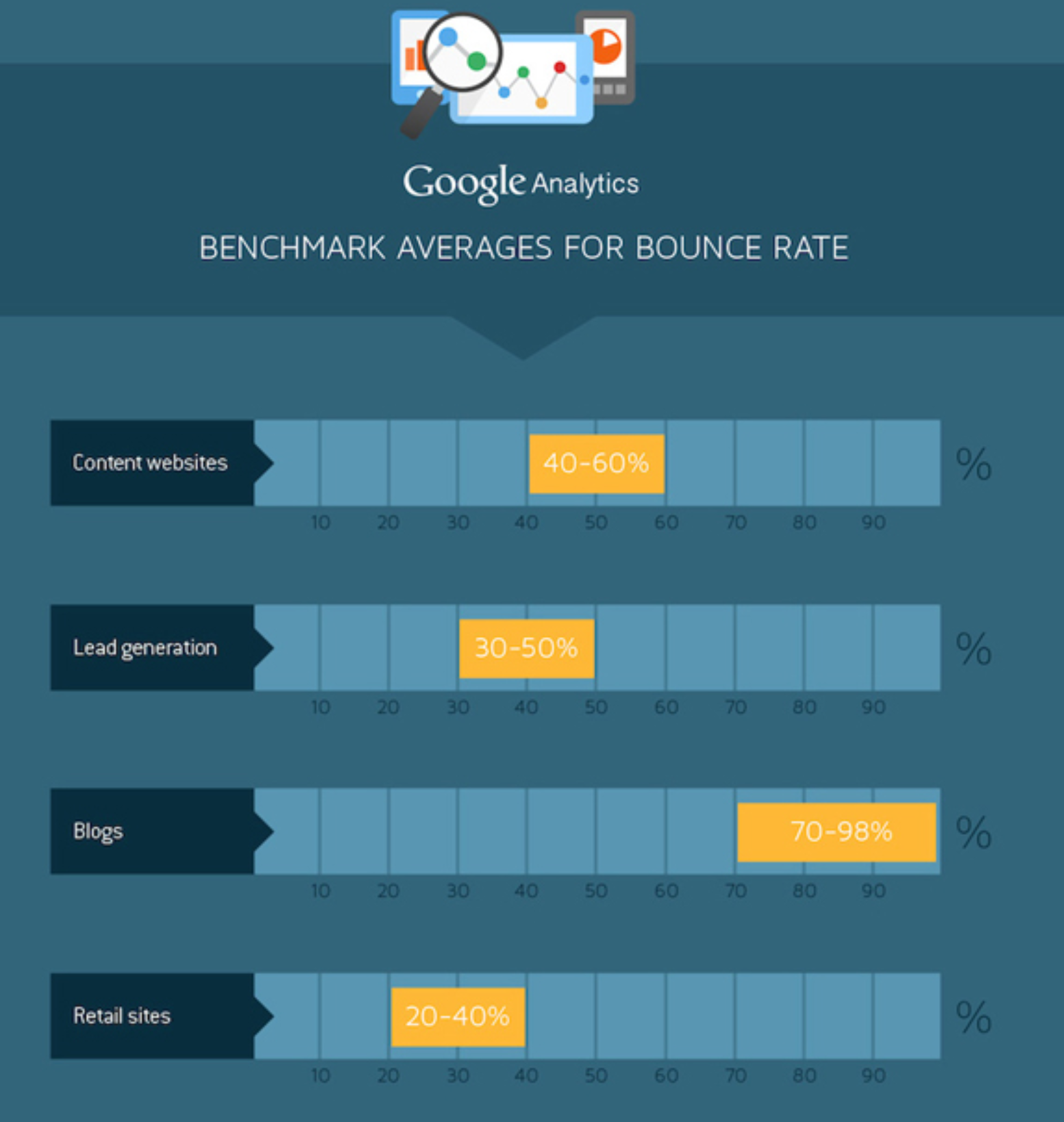
Source: HubSpot
The average bounce rate on mobile may be different from desktop bounce rates
The mobile bounce rate is often different from the desktop bounce rate, and it typically tends to be higher. Part of the reason for that is the psychology of mobile users, and part of it is simple technology logistics (e.g. 3/4/5g wifi).
Mobile devices tend to be more susceptible to load time lags, although that’s changing with newer model mobiles that are just as good as (and sometimes better than) a laptop or desktop.
Mobile requires a completely different user experience strategy.
The most important psychological aspect to keep in mind when it comes to mobile users is that they tend to be “on the go,” or passively browsing. On a laptop or desktop, users are typically browsing more intentionally, which can result in a lower bounce rate simply because they show up with the intention to purchase. They’re there because they need something.
What is the difference between bounce rate and exit rate in Google Analytics?
Bounce rate and exit rate are often used interchangeably in the ecommerce world. While they’re similar, there are some key differences.
To simplify, bounce rate is when visitors leave your site without visiting any other pages, while exit rate is when visitors leave after visiting more than one page. For a more in-depth dive into the difference between bounce rate and exit rate in Google Analytics, head over here.
Now that you have a good understanding of bounce rate, let’s jump into actionable ways to reduce it!
How to reduce your bounce rate?
Here are 17 tips on how to decrease bounce rate.
1. Provide a better user experience
One of the best ways to provide a good user experience is to make your content legible, clear, and properly formatted.
There are so many great businesses out there with attractive websites that suffer from higher bounce rates than they should have simply because they provide a poor user experience. Even if their content is the best out there, users will be turned off by things like large chunks of text, awful fonts, and general bad formatting.
Here are some proven ways to make your content more readable and easier on the eyes:
- Use subheadings to throw more light on your topic.
- Use bullet points to explain benefits or points worth noting.
- Use plenty of charts, images, screenshots, and quotes from industry experts (where appropriate).
- Bold keywords a few times (don’t overdo this).
- Ask plenty of questions in your content, giving readers an invitation to participate instead of just reading.
- End your content with a subheading entitled “conclusion.” This tells the reader to quickly read the last few words and take action. Make your conclusion actionable.
Moreover, you can use resources like read-able.com and Yoast to test readability and improve the user experience—and thus your bounce rate.
2. Make your website mobile friendly
Your prospects are likely viewing your content from many different devices. Are you optimizing your content for all screens?
If the answer is no, then you have your work cut out for you. Here are some stats to show you just how mobile the internet has become:
- Consumers spend between 5-6 hours a day on their mobile devices
- In 2020, mobile accounted for 55.7% of all website traffic worldwide
- 80% of Internet users own a smartphone
To make your site more mobile friendly, you can:
- Install a responsive theme
- Simplify your menus
- Keep forms as short as possible
- Clearly display your calls-to-action
- Make customer service easily accessible
- Include a search function

Source: Google Developers
These are just a few things you can do to create a more mobile-friendly experience. For examples of the action items mentioned above and more recommendations, check out this ultimate guide.
3. Increase site speed
Do your pages load in 2-3 seconds max? If your answer is “no,” or “I’m not sure,” this could be one of the reasons you’re experiencing a high bounce rate.
In ecommerce, site speed is the name of the game. The faster your pages load, the better. The faster prospects can checkout, the better. See where this is going?
Check out these statistics on consumer behavior to better understand just how important speed is when it comes to increasing conversions.
To boost your page load time, try some of these techniques:
- Evaluate current page speed by using the Pingdom Speed test tool
- Removing query strings from static pages to improve performance
- Optimize images with WordPress plugins
- Tweak the .htaccess file
4. Use relevant keywords
If you’re not attracting relevant, high-quality traffic to your website, you’ll almost certainly see a high bounce rate.
Keywords play a crucial role in content marketing and lead generation, so you have to make sure you’re targeting the right ones.
Look at it this way: Google makes over 95% of its revenue from advertising. This means that the lion’s share of their revenue comes from companies targeting expensive keywords.
High-value keywords improve your traffic, boost your conversion and engagement rates, and also bolster your online reputation and authority.
Tools like Google Keyword Planner, Ahrefs, and Moz can help you identify and evaluate potential keywords that can generate high-value traffic for your web pages. you can also use Google Trends API to extract your competitors’ top pages to see how they leverage certain keywords.
5. Attract the right visitors to your website
This goes hand-in-hand with the previous tip on keyword planning. In addition to solid keyword research, ensure that you have a well-planned content strategy. The wrong content (despite its quality) will lead to a higher bounce rate because it’s not targeted to the right audience.
Use this article from the Content Marketing Institute to guarantee that your content strategy ticks the right boxes.
6. Write attractive meta descriptions for search users
Meta descriptions are roughly 155 characters in length and their purpose is to effectively summarize a page’s content.
Search engines display the meta description in search results, which means that optimizing it should be a priority.
So how do you create an attractive meta description? Here are some pointers:
- Keep it at 155 characters
- Make sure it’s actionable and written in an active voice
- Include a call-to-action
- Ensure that it contains the right keywords
- Make sure it matches the content
- Try to make it unique

Source: Evolving SEO
7. Open external links in a new tab
Avoid “back button fatigue” by ensuring that when users click a link on your website, it opens in a new tab or window. This is another overlooked element in optimizing the user experience.
Think about your own browsing habits and just how much easier it is to look at various products and pieces of content when you can see them side by side, easily switching between tabs or windows.
8. Use a convincing call to action
Simple, punchy, and clear. That’s what you should aim for with your call to action.
Your CTA’s only goal is to make the visitor take the desired action.
The call-to-action is something even seasoned ecommerce experts mess up. It’s easy to be tempted to let the creativity flow and try all the latest “hacks” to convert visitors.
But remember, clarity beats creativity every single time. The last thing you want to do is confuse!
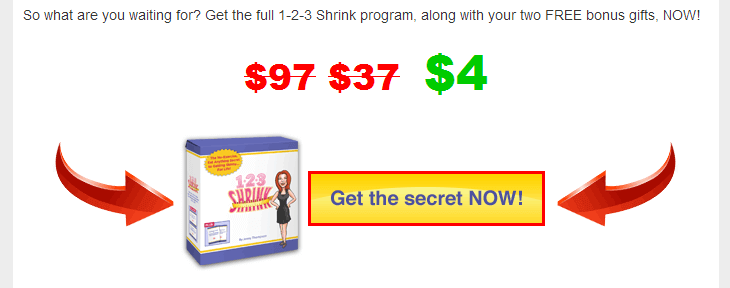
Source: CrazyEgg
9. Publish the right content regularly
High-quality content can also help to reduce your bounce rate.
Use websites like Buzzsumo and Ahrefs to discover trending terms and the type of content that’s doing well in your industry.
Take stock of the content you publish and the results you get. Those will serve as reference points for your content optimization experiments.
10. Display credibility
Unless you’re a household name or a Fortune 500 company, it’s likely that not everyone is going to be familiar with your brand.
Brands are born every single day in ecommerce, which means that displaying credibility is more important than ever.
Trust signals like encryption badges, HTTPS badges, and reputable payment options show your visitors that you’re a serious brand that values their safety, which works to reduce your bounce rate.
11. Use videos and podcasts to engage your visitors
Video is a powerful tool to reduce your bounce rate and increase your conversion rates.
According to Google, almost half of internet users search for product-related videos before even visiting an online store. That’s huge!
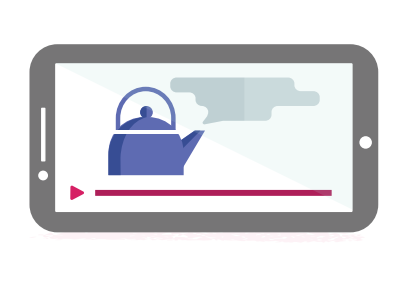
Source: Google
Plus, video adds a powerful dimension to your brand storytelling that can pull at your customers’ emotional heartstrings and create loyal buyers for years to come. Utilizing free green screen background videos for your projects can further enhance the visual appeal of your videos and engage your audience.
Another popular marketing/sales medium you shouldn’t overlook is audio. Podcasts and audio clips make your content more dynamic and give your visitors another way to engage with your brand.
12. Target abandoning visitors with exit-intent popups
Popups are very effective for the conversion optimization process.
However, they need to be used strategically, and never in a pushy way.
Well-timed, tailored exit-intent popups can not only curb your bounce rate but also help you build your email list!
If you’d like to start reducing your bounce rates right now, choose one of the templates below and set up an exit-intent popup in just a few minutes:
13. Target engaged users with personalized messages
Like exit-intent popups, personalized messaging is another crucial part of the conversion optimization process.
Tools like HotJar give you insight into user behavior, and then you can use OptiMonk’s powerful popups and embedded messages to keep your bounce rate low!
If you’d like to learn more about website personalization and how to create delightful shopping experiences for every customer, read our free guide now.
14. Insert helpful, strategic internal links
The proper use of internal links within your content keeps visitors on your website and increases the chances that they’ll become a customer.
If they accidentally landed on the wrong page on your website, a well-placed internal link can mean the difference between keeping them browsing and losing them forever.
15. Recommend content and products for your visitors
YouTube, Amazon, Spotify, and Netflix are just a few of the companies that have mastered the art of product and content recommendations.
Here’s a great example from Amazon. They recommend specific products to individual visitors based on their browsing history on the site:
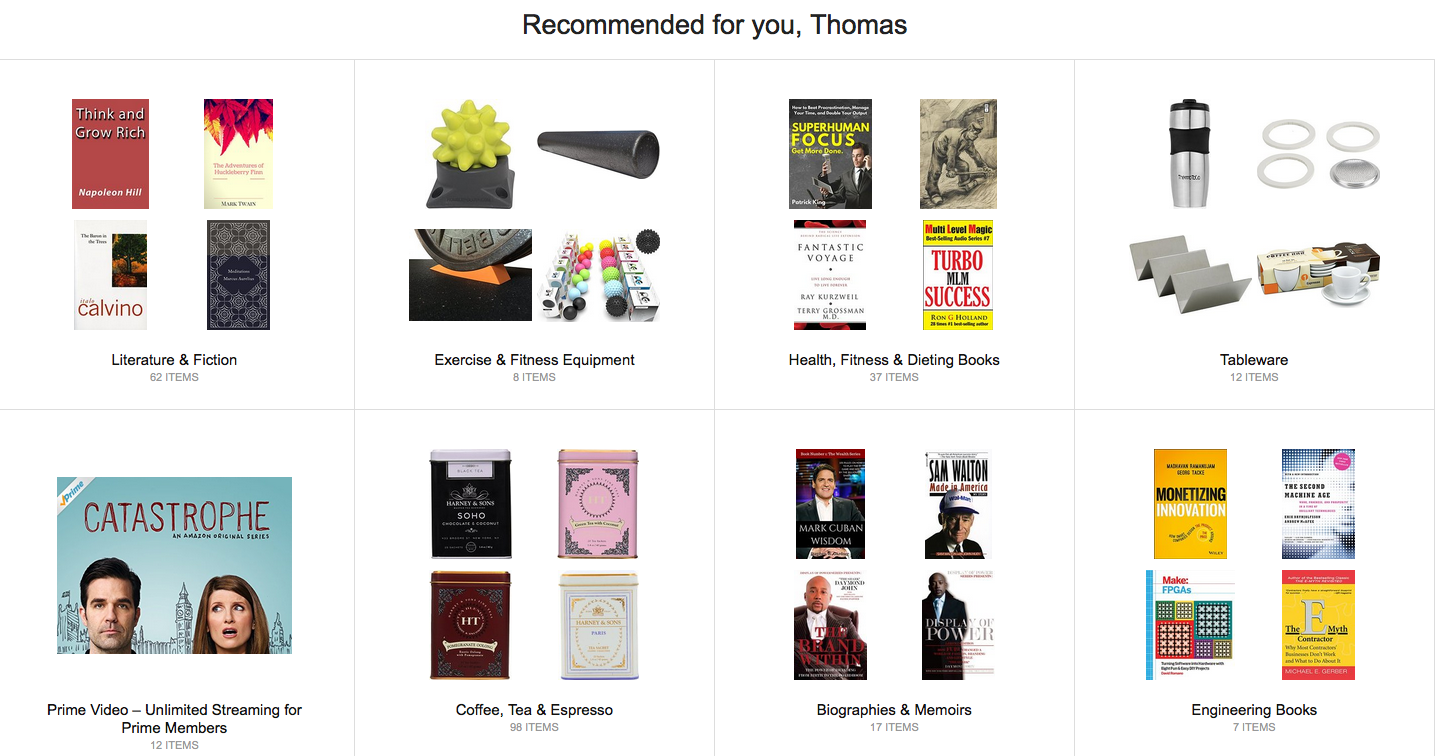
You can replicate this using personalization tools like OptiMonk.
Want a deep dive into upselling and cross-selling techniques? Head over here.
16. Simplify search and navigation
A search bar with autocomplete, faceted search, a large footer, and colorful animation are just a few of the many proven navigation techniques that can help keep your bounce rate low.
Here’s an example from Nordstrom that not only uses a beautiful feature-rich navigation system, but also helps users search with autocomplete:
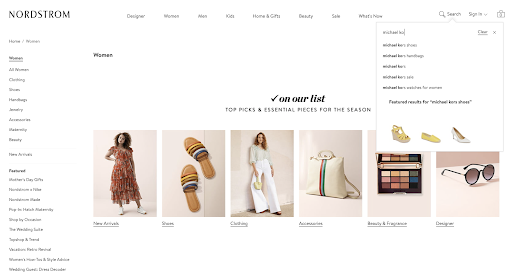
17. Limit broken links
Do yourself a favor and reduce the number of broken links on your website. They act as a repellent to visitors and cause them to bounce more than you might think.
Use Google Search Console to identify broken links on your site and replace them, add a redirect, or remove them altogether.
Final thoughts
A low bounce rate is definitely something you want to aim for, regardless of your industry. You want to keep site visitors on your web page for as long as possible because the longer they stick around, the more likely it is that they’ll come back and ultimately become customers.
But remember, you shouldn’t obsess over a high bounce rate, since it doesn’t tell the whole story. The ecommerce bounce rate is just a small piece of the puzzle that is conversion rate optimization.
Now over to you! Do you have any other techniques to reduce bounce rate that you’d add to this list? Let us know below! 👇
